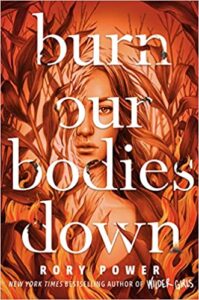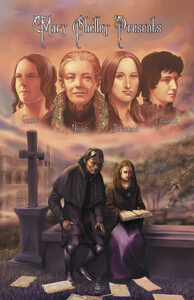
Burn Our Bodies Down by Rory Power
Delacorte Press, 2020
ISBN-13: 978-0525645627
Available: Hardcover, Kindle edition, audiobook, audio CD ( Bookshop.org | Amazon.com )
Seventeen-year-old Margot, trapped in a disturbing codependent relationship with her abusive mother, finally finds an escape after discovering she has a grandmother living just outside Phalene, a small town only a few hours away. Arriving in Phalene, Margot quickly meets Tess, daughter of a wealthy landowner whose property is next to Margot’s grandmother’s farm, and Tess’ friend Eli. Tess and Eli tell Margot her grandmother has a reputuation as an eccentric, but offer to walk her to her grandmother’s house. On the way, the three teens discover the property is on fire, and Eli carries a girl out of the fire who is identical to Margot in looks and age, but who Margot has never seen before. The police are suspicious and take all three to the station to question them, but are clearly focused on Margot, especially because this isn’t the first fire to take place on her grandmother’s property, and the two girls are so identical it’s hard to believe Margot doesn’t know her.
A significant part of the book has to do with Margot’s developing relationship with her grandmother. At first, her grandmother is loving and welcoming, if inflexible, but early on Margot realizes that her grandmother is also being evasive and, at times, outright lying to her. The reader will see clearly the similarities between the behaviors of Margot’s grandmother and mother; it becomes clear early on why Margot’s mother never wanted to speak about her family. Margot also begins a close friendship with Tess, which has the marks of the beginnings of a crush on her, but this is never followed through on. Margot, Tess, and Eli are determined to solve the mystery of the girl who died and how that might be related to the earlier fire, and Margot as well wants to learn about her family’s past. There is clearly something going on that her grandmother is hiding, and a diary Margot finds contains clues as to what led to her mother’s behavior and some of the reasons she may have passed the trauma of her own childhood on to Margot.
The science-fictional twist at the end leads to some particularly gruesome body horror, and thoughtful readers may still find themselves disturbed by the long-term consequences of not eliminating all of the loose ends. Burn Our Bodies Down punches up the action faster than Wilder Girls but meanders in the middle, until it reaches its fast-paced and gory conclusion. Power has done a great job of showing the effects generational trauma and the difficulty of breaking that cycle. Even in relationships that haven’t sustained the kind of damage as the family in this book, there are very few girls who want to grow up to be just like their mothers, and Burn Our Bodies Down does an excellent job of portraying a time of life when most girls are separating to explore and form their own identities.






Follow Us!